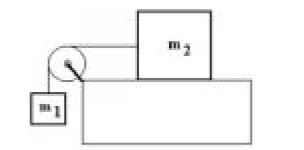After a proton with an initial speed of 1.50 × 105 m/s has increased its speed by accelerating through a potential difference of 0.100 kV, what is its final speed? (e = 1.60 × 10-19 C , mproton = 1.67 × 10-27 kg)
A) 3.55 × 105 m/s
B) 8.80 × 105 m/s
C) 2.04 × 105 m/s
D) 4.56 × 105 m/s
E) 1.55 × 106 m/s
C
You might also like to view...
The condensation hypothesis proposes that the Moon formed when an object estimated to have been at least as large as Mars smashed into the proto-Earth
Indicate whether the statement is true or false
The unit V is the same as a
A. N/m. B. J/N. C. C/m. D. J/C. E. C/N.
A 1500-kg car traveling at 90 km/h toward the east suddenly collides with a 3000-kg car traveling at 60 km/h toward the south
The two cars stick together after the collision. What is the speed of the cars after collision? A) 8.3 m/s B) 14 m/s C) 17 m/s D) 22 m/s
Two masses are connected by a cord that passes over a pulley as shown in the figure. The pulley and the cord have negligible mass and  (6.0 kg) moves on a horizontal surface with a coefficient of friction of 0.5,
(6.0 kg) moves on a horizontal surface with a coefficient of friction of 0.5,  (2.0 kg) is suspended vertically. What is the acceleration of
(2.0 kg) is suspended vertically. What is the acceleration of  ?
?

A. 0.0 
B. 3.0 
C. 1.0 
D. 2.9 